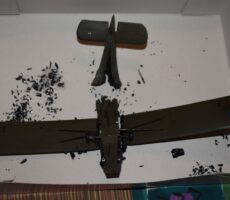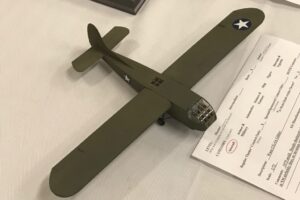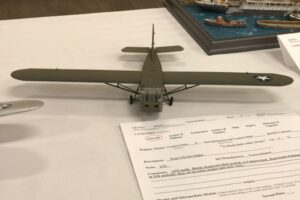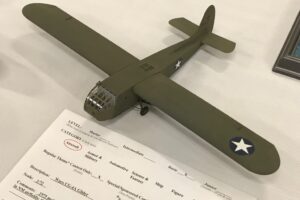Waco CG-4 Glider Build for the Cavalcade of Wings
The Cavalcade of Wings display at the Albuquerque airport had a model that was disintegrating. It was a Waco CG-4A that was used for training in New Mexico during World War Two. Fort Sumner was one of six NM glider fields and it was the hub of advanced instruction. The current Fort Sumner airfield is the old glider field. The current airfield at Tucumcari is also an old glider field. There were others. If you look on Google Earth 15 miles ENE from Clovis you’ll find the ghostly remains of field #5 in the middle of a wind farm, with a cattle tank in the middle of it. There were others. Cutter-Carr was the civilian contractor supplying instructors, a familiar name.
As you can see, the fuselage, which is made from some solid black cast material, disintegrated, as if it had taken a direct hit! This was not due to physical mistreatment but internal stresses finally tearing it apart. Usually I can salvage/repair models for the Cavalcade of Wings, but I decided to just start over. I don’t know how old this original was but it has raised lettering on the under surface of a wing, so it was an old kit. Fortunately Italeri made one in 1/72, a 1975 mold, and I snagged one on eBay. It has a rudimentary interior (seats along the wall) and a basic cockpit. Since this is for a museum, and most patrons would likely not understand why the glider’s nose was “broken,” I built it with the swing-up cockpit down so there was little reason to doll-up the interior. You could drive a Jeep into one of these! I would have done more with the cockpit had I realized how visible it is with the greenhouse windshield – painted with Future!
The actual build was simple right out of the box. While the Wacos we see in the D-Day movies have the invasion recognition stripes, the trainers did not have them (preserving my stash of black and white trim film). I resisted filling the wing-fuselage join since these had a big gap. They were kit planes with removable wings.
The Italeri decals disintegrated on contact with water, so I had to use some stars from my stash. Since the stars on the demolished models were the early ones without the “paddles,” I removed the paddles with a little surgery. They are not quite right, since the tips of the stars should go all the way to the edge, but since the viewers will be feet away, and unaware of this detail, good enough. Apparently, some trainers didn’t have numbers or they were painted out, so I didn’t worry over the disintegrated tail numbers. Here’s a photo of a training wreck with numbers painted over. You can barely see the old numbers under the paint.
One final thing about these gliders is that while there are landing gear, there are also skids for when the wheels tear off in the soft soil of the farmer’s fields in Normandy.
So, here’s the final product. You can see the skids under the cockpit. See what I mean about the visibility through the greenhouse windshield? Oh, and there’s a window in the top of the fuselage as well as small portholes in the side.
I invite all of you to build for the Cavalcade of Wings. Museum builds get far more “views” than they do on your own shelf.













